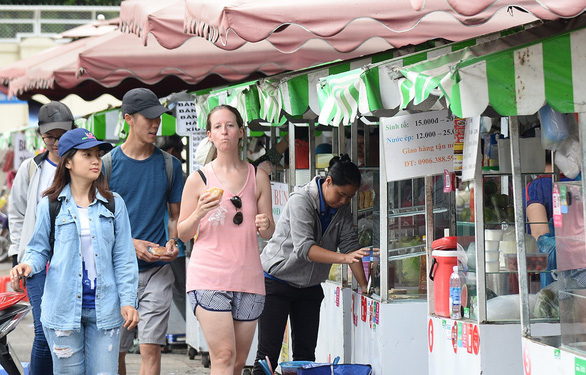The scheme of designating areas for street food vendors to do business legally without having to infringe on public space in Ho Chi Minh City has proved to be a success, two years into implementation.
While street food is an important part of Vietnamese culture, food hawkers in Vietnam, particularly in big cities, usually occupy sidewalks for their business, hurting cityscape and affecting urban order.
In 2017, district-level administrations across Ho Chi Minh City launched a campaign aimed at providing a legitimate place for street food vendors by putting aside areas, loosely called ‘food streets,’ for them to run their stalls.
The goal was to kill two birds with one stone: clearing sidewalks of encroachment while ensuring street food vendors could still earn their livelihood.
Nguyen Van Chiem Street, located only a few steps from the Notre-Dame Cathedral Basilica in District 1, was turned into the city’s first-ever food street in August 2017, with long-time, poor street food vendors selected to open stalls there.
The second hub for hawkers was opened at Bach Tung Diep Park in the same district in October that year.
More of such food hubs were established after surveys had been carried out on 159 streets in the city to find suitable places.
Two years after relocating to Nguyen Van Chiem Street, Nguyen Van Thanh, who runs a lunch stall with his wife, said they felt happy to have followed the call of local authorities to stop selling on the streets and move to the food street.
Earning a living on the streets meant Thanh had to constantly watch out for urban management officers, he recalled.
“Whenever officers came, we had to run from them, which hurt our income that day,” he told Tuoi Tre (Youth) newspaper.
No such fear now exists for Thanh and his wife, who serve lunches to hundreds of customers every day from their booth on Nguyen Van Chiem Street.
While his family used to be occasionally unable to afford daily expenses selling on the streets, their financial condition has greatly improved over the last two years, he said.
“We are now able to raise our three children and even have savings to buy necessary appliances for our house,” he proudly added.
Nguyen Thi Trong, a breakfast seller on the Le Binh food street located in Tan Binh District, also shared with Tuoi Tre that she has earned greater incomes since shifting from selling on the streets to this legitimate place.
Trong is able to pay her bills and afford school fees for her children.
Likewise, about 16 once-street vendors are enjoy doing business at the Ong Nam Hap Market, another zone designated for hawkers located on T1 Street in Tan Phu District.
The grassroots administrations have contributed greatly to the success of the ‘food street’ model, thanks to their strategic and strict management.
For instance, authorities of Ben Nghe Ward, home to the Nguyen Van Chiem food street, train vendors annually in manners, food safety, waste sorting, and fire prevention.
The ward administration also regularly tasks officers with inspecting the food street to monitor vendors’ operations.
As the existing venue started to bear fruit, the Ben Nghe administration has plans to gather hawkers in more designated areas on such streets as Chu Manh Trinh, Huynh Thuc Khang, and Thai Van Lung, as well as Alley No.17 on Le Duan Street, according to Vo Quoc Hung, the ward’s deputy chairman
Like us on Facebook or follow us on Twitter to get the latest news about Vietnam!

















































